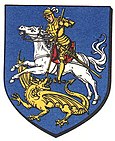Melsheim
| Melsheim | ||
|---|---|---|

|
|
|
| region | Grand Est | |
| Department | Bas-Rhin | |
| Arrondissement | Saverne | |
| Canton | Bouxwiller | |
| Community association | Pays de la Zorn | |
| Coordinates | 48 ° 45 ′ N , 7 ° 31 ′ E | |
| height | 158-236 m | |
| surface | 5.21 km 2 | |
| Residents | 591 (January 1, 2017) | |
| Population density | 113 inhabitants / km 2 | |
| Post Code | 67270 | |
| INSEE code | 67287 | |
Melsheim is a French commune with 591 inhabitants (as of January 1, 2017) in the Bas-Rhin department in the Grand Est region ( Alsace until 2015 ). On January 1, 2015, the municipality moved from the Arrondissement Strasbourg-Campagne to the Arrondissement Saverne . She is a member of the Communauté de communes du Pays de la Zorn .
history
middle Ages
In 1348 the inhabitants of Melsheim placed themselves under the protection of the Lords of Lichtenberg . From then on, they regarded the village as an allod and assigned it to their office in Buchsweiler , which was established at the beginning of the 14th century as an office of the Lichtenberg rule .
Anna von Lichtenberg (* 1442; † 1474), daughter of Ludwig V. von Lichtenberg (* 1417; † 1474), and one of two heirs with claims to the rule, married Count Philip I the Elder of Hanau-Babenhausen in 1458 (* 1417; † 1480). He had received a small secondary school from the holdings of the County of Hanau in order to be able to marry her. The county of Hanau-Lichtenberg came into being through the marriage . After the death of the last Lichtenberger, Jakob von Lichtenberg , an uncle of Anna, Philipp I. d. Ä. 1480 half of the Lichtenberg rule. The other half went to his brother-in-law, Simon IV. Wecker von Zweibrücken-Bitsch . The Buchsweiler office - and thus ### - belonged to the part of Hanau-Lichtenberg that Anna's descendants inherited.
Modern times
Count Philip IV of Hanau-Lichtenberg (1514–1590), after taking office in 1538, consistently carried out the Reformation in his county, which now became Lutheran .
With France's reunification policy under King Louis XIV , the Buchsweiler office came under French sovereignty. After the death of the last Hanau count, Johann Reinhard III. In 1736, Hanau-Lichtenberg - and with it the Buchsweiler office - fell to the son of his only daughter, Charlotte , Landgrave Ludwig (IX) of Hesse-Darmstadt . With the upheaval started by the French Revolution , ### became French.
Population development
| 1798 | 1962 | 1968 | 1975 | 1982 | 1990 | 1999 | 2006 | 2017 |
|---|---|---|---|---|---|---|---|---|
| 456 | 454 | 465 | 457 | 435 | 478 | 534 | 581 | 591 |
literature
- Fritz Eyer: The territory of the Lords of Lichtenberg 1202-1480. Investigations into the property, the rule and the politics of domestic power of a noble family from the Upper Rhine . In: Writings of the Erwin von Steinbach Foundation . 2nd edition, unchanged in the text, by an introduction extended reprint of the Strasbourg edition, Rhenus-Verlag, 1938. Volume 10 . Pfaehler, Bad Neustadt an der Saale 1985, ISBN 3-922923-31-3 (268 pages).
- Alfred Matt: Bailliages, prévôté et fiefs ayant fait partie de la Seigneurie de Lichtenberg, du Comté de Hanau-Lichtenberg, du Landgraviat de Hesse-Darmstadt . In: Société d'Histoire et d'Archaeologie de Saverne et Environs (Eds.): Cinquième centenaire de la création du Comté de Hanau-Lichtenberg 1480 - 1980 = Pays d'Alsace 111/112 (2, 3/1980), p 7-9.
- Le Patrimoine des Communes du Bas-Rhin . Flohic Editions, Volume 1, Charenton-le-Pont 1999, ISBN 2-84234-055-8 , pp. 517-518.
Web links
Individual evidence
- ↑ http://www.legifrance.gouv.fr/eli/decret/2014/12/29/2014-1722/jo/texte
- ↑ Eyer, pp. 58, 116, 232f.
- ↑ Eyer, p. 238.
- ^ Matt, p. 7.
